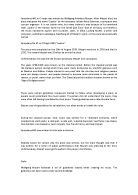Transition
The start of the transition is immediately in contrast to the beginning of the piece, starting at piano dynamic markings and without any bass, helping to create a delicate texture. Motif A features in the transition, in the violins, but is also marked piano, with the horns playing the tonic triad. The counter melody is then played, starting in bar 26 in the woodwinds, accompanied by motif A in the strings. The horns again play the triad, but this time starting on the dominant. From bar 31 it starts to change, as the piece begins to develop and move on. The violins begin to play a fragmentation of the consequent of motif A, using appoggiaturas and a sequence to disguise the progression of 5ths (from A7, to D7, G7 then C7), taking place every bar. Meanwhile the bassoons play 3 crotchets in a chromatic motion, helping for smoother development and linking. All the meanwhile this is still piano, when in bar 37 it suddenly becomes forte, contrasting with the previous section. This new section starts in the key of G major. In bar 39 the consequent appears again, but this time in the bassoon, in a high register, creating a reedy and distinctive timbre as well as the top of the cello range. The brass start playing an augmented version of the fanfare, meanwhile there is an inverted pedal being played in the flutes, lasting 8 bars from bar 39 onwards. At bar 44 the fragmented consequent appears again in the bassoons, and the brass start to play the original fanfare from motif B. In bar 49, the brass and bass start to play a pedal, as the whole of motif B is reintroduced into the orchestra, in the dominant of G; climaxing at bar 55 with a general pause.
Second Subject
Again this section starts in contrast to the end of the transition, with only the violins playing in a 2-part texture, with the second subject in the first violins and the accompaniment in the seconds. The bass then joins in at bar 58, leading to the end of the phrase at bar 61. In this bar the first violins pay a short ascending passage, reminiscent of bar 38 in the flutes which brings back the second subject, but now in a 3 part texture with the bassoons now also joining in. Several bars later in bar 64 the violas and bass also join in, imitating the first part of the second subject, and helping to build the texture of the piece. In bar 68, the flutes also join in, doubling what the strings are playing until the melody stops and the phrase ends in bar 71. In this same bar the bass and violas start playing a phrase similar to the consequent, which then leads into a cadential phrase all the way up to bar 79, which has no accompanying brass or woodwind, ending in G7, setting the piece up for C minor. At the end of the cadential passage, the strings are playing 3 crotchets in a row, which is similar to what was played in bars 31 by the woodwind.
However, the C minor section doesn’t start until after a bar of silence from the orchestra, helping to create a sense of tension and anxiety, which the piece then interrupts with a sudden forte. Here Mozart uses several techniques to help add to the drama, first the timpani plays an augmented fanfare, adding to the texture with percussion meaning the whole orchestra is now playing, and the violins play a G tremolo, creating a sense of excitement. The piece moves into C major at bar 83, the subdominant of G major. In bar 88 the passing note of F sharp helps to establish G major, as it is the leading note, and in bar 99 the piece is firmly established as G major with an inverted pedal of G in flutes and oboes, and a pedal in the brass. Here the bassoons play a rising sequence, which features rhythmic diminution of the consequent from motif A. In bar 93 this same sequence appears in the bass, violas and second violins as well as the woodwind, repeating it and helping to make the texture thicker, and at the same time the first violins are playing in syncopation with the rest of the orchestra, adding to the excitement and drive. In bar 99 the rest of the orchestra has dropped out suddenly, leaving the first violins with a solo at piano markings, and another general pause.
Closing Theme
Bar 101 - 110 sees a whole piano section, helping to bring the second subject to an end bit by bit. It starts with the tune being played in the violins starting on D, using anacrusis to help add to the now lighter atmosphere, almost as if Mozart is teasing the listeners and joking around. In bar 103 the oboes play an inverted pedal quietly, with the bassoons joining in at bars 105, also piano, playing the closing theme starting on G. Because of the light atmosphere and texture in this section, there are no parts for the brass or timpani.
Codetta
The codetta begins at bar 111, starting at a forte dynamic, leading towards the end of the exposition. The main melody is played in the oboes and bassoons, as well as the bass and viola, while the rest of the orchestra except the timpani accompany them. The first and second violins are playing semi-quavers, which helps build the tension and excitement as the exposition draws to a close. At bar 117 the piece changes, with a cadential passage with most notes on the beat, with the first violins playing demi-semi-quavers, reminiscent of the first subject, mirroring motif A. Here the flutes are playing a pedal, the codetta ending at bar 121.







